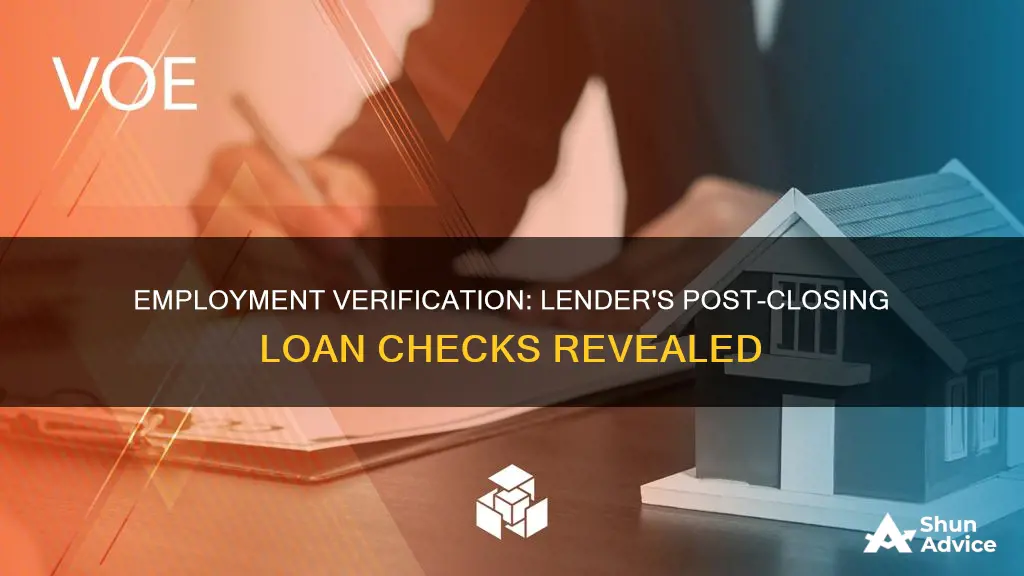
Lenders typically verify employment twice: when you apply for a home loan and several days before closing. They don’t usually check your employment after closing, but they may in some cases. Loan companies verify employment multiple times to ensure they are lending to someone with a stable income who can afford to pay back their loan. This is especially important as a mortgage is a significant investment for a bank, and job verification is one way the bank minimizes risk.
| Characteristics | Values |
|---|---|
| How many times do lenders verify employment? | Lenders typically verify employment twice: when the borrower applies for a home loan and several days before closing. |
| Do lenders verify employment after closing? | Lenders rarely verify employment after closing but may do so in special circumstances. |
| What do lenders do to verify employment? | Lenders may confirm employment via phone call, fax, email, or a combination of these methods. They may also review documents such as pay stubs and tax returns. |
| Why do lenders verify employment? | Lenders need to verify employment to ensure the borrower has a stable income and can afford to repay the loan. |
| What happens if the borrower loses their job during the mortgage approval process? | The borrower should inform their lender immediately. Losing their job may affect whether the loan moves forward, but the lender may be able to work out an alternative plan. |
What You'll Learn

Lenders typically verify employment twice
The first verification happens when you apply for the mortgage. The lender wants to know that you were honest about your income on your application and that you earn enough to meet the loan requirements. Lenders spend the most time on the first employment verification. They will verify this information during the underwriting process to approve you for a mortgage. This process happens days to weeks before closing.
The second verification typically takes less time and can be a verbal confirmation that you still work in the same position. It is usually done within 10 days of the wire to ensure the borrower still works there and that the position on the application is correct. Mortgage lenders have to call your employer on a phone number that can be verified by a third party, such as Google. This third-party verification requirement can present difficulties when dealing with small companies that may not have a website or nonprofits.
Mortgage employment verification is used to confirm that you can afford to pay back your home loan. It is part of the underwriting process, where an underwriter researches your current income, debt level, credit history, and other factors to determine whether you can repay the loan. Based on their research, the underwriter recommends whether the lender should approve or deny your loan application.
Koha's Interlibrary Loan System: How Does It Work?
You may want to see also

Employment verification is part of the underwriting process
Employment verification is an important part of the mortgage process. It is conducted to confirm that you can afford to pay back your home loan. This process is done during the underwriting process, which is when an underwriter reviews and verifies the information provided by the borrower to the lender. The underwriter researches the borrower's current income, debt level, credit history, and other factors to determine whether they can repay the loan.
The first verification happens when you apply for the mortgage. The lender wants to confirm that you were honest about your income on your application and that you earn enough to meet the loan requirements. The second verification typically takes less time and can be a verbal confirmation that you still work in the same position. Lenders typically verify your employment twice: when you apply for a home loan and several days before closing. They don’t usually check your employment after closing, but they may in some cases.
The employment verification process can be done in several ways. The lender may call the employer to confirm the details in the VOE forms, or they may look up the borrower's tax transcripts to confirm their employment information aligns with their W2s. Tax documents are the primary way loan companies research self-employed applicants. If the borrower is self-employed, they can have their income attested by a certified public accountant and provide an IRS Form 4506-T to confirm their employment.
Mortgage lenders need to check that the borrower is and has been employed to ensure they’re taking into consideration all of their income sources. This confirms that the borrower can cover their down payment and any closing costs. Lenders want to minimize the risk of approving loans for borrowers who might struggle with mortgage payments.
Lender Review: What Happens When Your Loan is Paid Off?
You may want to see also

Verbal Verification of Employment (VVOE)
Lenders use a verbal verification of employment (VVOE) to ensure that a borrower is likely to repay a loan. The VVOE process ultimately serves to reduce the risk for lenders, which is why it is generally performed near the end of the loan process. Lenders typically verify employment twice: when the borrower applies for a home loan and several days before closing. They rarely check a borrower's employment after closing but may do so in some cases.
The VVOE process can vary depending on the lender and whether the borrower is self-employed. If the borrower is self-employed, they will be much more involved in the VVOE process. The process typically goes as follows: the borrower applies for a loan, which initiates the VVOE process; the borrower completes Form 4506, a request for a copy of their tax return to give to the lender; the borrower contacts their accountant or the Certified Public Accountant (CPA) of the company they do contract work for to inform them that they are applying for a loan; the lender contacts the borrower's accountant or company CPA to confirm their income; the loan is closed and delivered once the borrower's income is verified.
The VVOE is generally a small part of the overall loan process and doesn't take much time, but there are factors that can cause things to take longer than anticipated. For example, sudden job changes can happen, especially for the self-employed. This can be a disqualifying event for a loan in some cases. If this happens, the borrower should explain to the lender why they changed jobs so quickly, and the lender may simply run through the verification process again, causing a slight delay. In many cases, lenders will be understanding, and even if the borrower is disqualified from a loan, they can always reapply once things have settled down.
Mortgage lenders use the VVOE to calculate several metrics to determine the likelihood that a borrower will repay a loan. When verifying employment, a lender will frequently ask other questions as well. The lender may inquire about the likelihood of continued employment, and they are also interested in verifying position, salary, and work history. While lenders usually only verify the borrower's current employment situation, they may want to confirm previous employment details.
Lenda's Loan Services: Availability and Options
You may want to see also

Lenders may pull approval if you quit before closing
Lenders typically verify employment twice: when you apply for a home loan and several days before closing. They don't usually check your employment after closing, but they may in some cases. Loan companies verify employment multiple times to ensure they can lend to you with confidence. A mortgage is a significant investment for a bank, and job verification is one way the bank minimizes risk.
A change in employment status can have a significant impact on your mortgage eligibility. Lenders see a job change as a lack of stability that can disqualify you from a loan. Therefore, it is recommended that you avoid an immediate job change, especially if it results in delayed mortgage payments or financial uncertainty. If you lose your job during the mortgage approval process, you must inform your lender right away. Losing your job may affect whether your loan moves forward, but by informing your lender, you may be able to work out an alternative plan.
Mortgage lenders use the information they gather about your employment to calculate several metrics to determine the likelihood that you will repay a loan. When verifying employment, a lender will frequently ask about the likelihood of continued employment. They are also interested in verifying position, salary, and work history. While lenders usually only verify the borrower's current employment situation, they may want to confirm previous employment details.
There are several steps that borrowers can take if employers refuse to verify employment. Lenders may verbally verify the information provided on the Uniform Residential Loan Application, but they may also confirm the data via fax, email, or a combination of all three methods. If the lender can't verify your employment through the human resources department, be sure to call the department and explain your situation. You can also ask the lender whether supporting documentation, such as recent pay stubs, tax returns, and W-2s, will be sufficient.
Relocating for Residency: Laurel Road and Loan Options
You may want to see also

Lenders may conduct a new employment verification when refinancing
Lenders typically verify employment twice: when you initially apply for a home loan and several days before closing. However, they may conduct a third verification after closing under special circumstances, such as suspected fraud, application inconsistencies, or loan buyouts from another lender.
Lenders may also conduct a new employment verification when refinancing. This is because refinancing is similar to applying for a new loan, and lenders need to be confident that the borrower has a stable income to repay the refinanced loan. The refinancing process may involve the same steps as the initial loan application, including employment verification.
During the refinancing process, the lender will typically pull the borrower's credit for a second time in the days leading up to closing. They will also verify the borrower's employment, which can be done verbally or through documentation such as pay stubs, tax returns, and W-2s. Lenders may also request Verification of Employment (VOE) forms, which include details such as job title, time at the company, salary history, and bonuses.
If a borrower changes jobs during the refinancing process, it is important to communicate this to the lender as soon as possible. While a job change may not automatically disqualify the borrower, it can impact their eligibility. Lenders view job changes as a potential lack of stability, and consistent employment contributes to financial stability after closing. Therefore, it is advisable to maintain steady employment for a few months before and after refinancing to ensure financial stability and avoid complications with early repayment penalties.
Leasing a Vehicle: A Loan or Not?
You may want to see also
Frequently asked questions
No, lenders rarely verify your employment after closing, but they may do in some cases.
Lenders need to be confident that you have a stable income to buy a home. A mortgage is a significant investment for a bank, and job verification is one way the bank minimizes risk.
Lenders verify employment by contacting employers and reviewing documents, such as pay stubs and tax returns. They may also confirm the data via fax, email, or a combination of all three methods.
Employment verification is called the underwriting process. An underwriter researches your current income, debt level, credit history, and other factors to determine whether you can repay the loan.
You should inform your lender right away. Losing your job may affect whether your loan moves forward, but by informing your lender, you may be able to work out an alternative plan.







